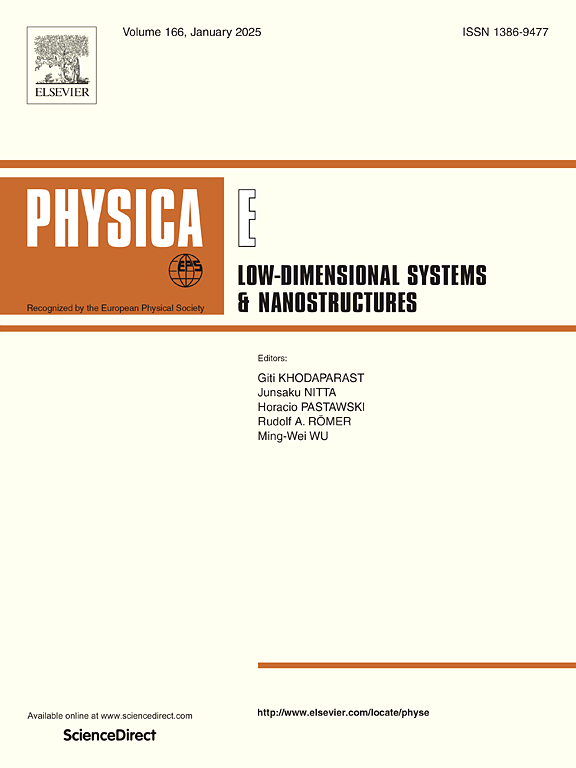相互作用的 T 型双量子点系统中的约瑟夫森效应和热相效应
IF 2.9
3区 物理与天体物理
Q3 NANOSCIENCE & NANOTECHNOLOGY
Physica E-low-dimensional Systems & Nanostructures
Pub Date : 2024-11-08
DOI:10.1016/j.physe.2024.116142
引用次数: 0
摘要
本文从理论上分析了 T 型双量子点约瑟夫森结的相位和热驱动传输特性。我们首先研究了中心量子点上不同点上库仑相互作用和量子点间隧道的约瑟夫森电流。在量子点能级低于费米级的情况下,约瑟夫森电流在库仑相互作用与点-引线耦合比中间呈现 0-π 相变。当库仑相互作用与点-铅耦合比相对较大时,约瑟夫森电流在双态中表现出完全的π相。点间隧道破坏了 π 区域,并根据量子点能级的位置移动了 0-π 转换点。此外,根据中心量子点能级的位置和库仑相互作用强度的不同,约瑟夫森电流显示出法诺类型的对称和不对称线形,并在侧点的费米级出现法诺凹陷。接着,我们证明了随着热能的增加,约瑟夫森电流的不连续性会逐渐消失,变成正弦波。最后,通过在结点上施加有限温度偏压,分析了总电流(约瑟夫森电流+准粒子电流)。该系统在电气开路配置下进行研究,其中相位驱动的约瑟夫森电流和热驱动的准粒子电流相互抵消,并分析线性响应区域的热相塞贝克效应。在约瑟夫森电流显示不连续的 0-π 过渡点,热梯度会产生突变的热相塞贝克系数 (TPSC) 峰值,而隧道间的强度可极大地控制这些突变的 TPSC 峰值。本文章由计算机程序翻译,如有差异,请以英文原文为准。
Josephson and thermophase effect in interacting T-shaped double quantum dots system
This article theoretically analyzes the phase and thermal driven transport properties in a T-shaped double quantum dot Josephson junction. We began by investigating the Josephson current for different on-dot Coulomb interaction on central quantum dot and interdot-tunneling between quantum dots. Josephson current exhibits phase transition for intermediate Coulomb interaction to dot-lead coupling ratio with quantum dots energy level below the Fermi level. The Josephson current exhibits complete -phase in doublet regime for relatively large Coulomb interaction to dot-lead coupling ratio. The interdot-tunneling destroys the region and shifts the transition points depending on the position of quantum dot energy levels. Further, depending on the position of central quantum dot energy level and Coulomb interaction strength, Josephson current shows Fano types symmetric and asymmetric line shapes with a Fano dip at the Fermi level of side dot. Next, we demonstrated that with increasing thermal energy, the discontinuity in the Josephson current smeared and becomes sinusoidal. Finally, the total current (Josephson current+quasi-particle current) is analyzed by applying a finite temperature biasing across the junction. The system is examined in electrically open circuit configuration, where phase driven Josephson current and thermal driven quasi-particle cancels each other, and analyze the thermophase Seebeck effect in linear response region. At the transition points, where the Josephson current shows discontinuities, the thermal gradient produces abrupt thermophase Seebeck coefficient (TPSC) peaks, and the strength of interdot-tunneling provides great control over these abrupt TPSC peaks.
求助全文
通过发布文献求助,成功后即可免费获取论文全文。
去求助
来源期刊
CiteScore
7.30
自引率
6.10%
发文量
356
审稿时长
65 days
期刊介绍:
Physica E: Low-dimensional systems and nanostructures contains papers and invited review articles on the fundamental and applied aspects of physics in low-dimensional electron systems, in semiconductor heterostructures, oxide interfaces, quantum wells and superlattices, quantum wires and dots, novel quantum states of matter such as topological insulators, and Weyl semimetals.
Both theoretical and experimental contributions are invited. Topics suitable for publication in this journal include spin related phenomena, optical and transport properties, many-body effects, integer and fractional quantum Hall effects, quantum spin Hall effect, single electron effects and devices, Majorana fermions, and other novel phenomena.
Keywords:
• topological insulators/superconductors, majorana fermions, Wyel semimetals;
• quantum and neuromorphic computing/quantum information physics and devices based on low dimensional systems;
• layered superconductivity, low dimensional systems with superconducting proximity effect;
• 2D materials such as transition metal dichalcogenides;
• oxide heterostructures including ZnO, SrTiO3 etc;
• carbon nanostructures (graphene, carbon nanotubes, diamond NV center, etc.)
• quantum wells and superlattices;
• quantum Hall effect, quantum spin Hall effect, quantum anomalous Hall effect;
• optical- and phonons-related phenomena;
• magnetic-semiconductor structures;
• charge/spin-, magnon-, skyrmion-, Cooper pair- and majorana fermion- transport and tunneling;
• ultra-fast nonlinear optical phenomena;
• novel devices and applications (such as high performance sensor, solar cell, etc);
• novel growth and fabrication techniques for nanostructures

 求助内容:
求助内容: 应助结果提醒方式:
应助结果提醒方式:


